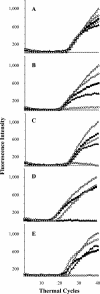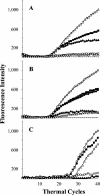Rapid detection of rifampin resistance in Mycobacterium tuberculosis isolates from India and Mexico by a molecular beacon assay
- PMID: 15583274
- PMCID: PMC535244
- DOI: 10.1128/JCM.42.12.5512-5516.2004
Rapid detection of rifampin resistance in Mycobacterium tuberculosis isolates from India and Mexico by a molecular beacon assay
Abstract
We assessed the performance of a rapid, single-well, real-time PCR assay for the detection of rifampin-resistant Mycobacterium tuberculosis by using clinical isolates from north India and Mexico, regions with a high incidence of tuberculosis. The assay uses five differently colored molecular beacons to determine if a short region of the M. tuberculosis rpoB gene contains mutations that predict rifampin resistance in most isolates. Until now, the assay had not been sufficiently tested on samples from countries with a high incidence of tuberculosis. In the present study, the assay detected mutations in 16 out of 16 rifampin-resistant isolates from north India (100%) and in 55 of 64 rifampin-resistant isolates from Mexico (86%) compared to results with standard susceptibility testing. The assay did not detect mutations (a finding predictive of rifampin susceptibility) in 37 out of 37 rifampin-susceptible isolates from India (100%) and 125 out of 126 rifampin-susceptible isolates from Mexico (99%). DNA sequencing revealed that none of the nine rifampin-resistant isolates from Mexico, which were misidentified as rifampin susceptible by the molecular beacon assay, contained a mutation in the region targeted by the molecular beacons. The one rifampin-susceptible isolate from Mexico that appeared to be rifampin resistant by the molecular beacon assay contained an S531W mutation, which is usually associated with rifampin resistance. Of the rifampin-resistant isolates that were correctly identified in the molecular beacon assay, one contained a novel L530A mutation and another contained a novel deletion between codons 511 and 514. Overall, the molecular beacon assay appears to have sufficient sensitivity (89%) and specificity (99%) for use in countries with a high prevalence of tuberculosis.
Figures


Similar articles
-
Detection of rifampin resistance in Mycobacterium tuberculosis in a single tube with molecular beacons.J Clin Microbiol. 2001 Nov;39(11):4131-7. doi: 10.1128/JCM.39.11.4131-4137.2001. J Clin Microbiol. 2001. PMID: 11682541 Free PMC article.
-
Characterization of rpoB mutations in rifampin-resistant clinical Mycobacterium tuberculosis isolates from Kuwait and Dubai.Diagn Microbiol Infect Dis. 2002 Nov;44(3):245-52. doi: 10.1016/s0732-8893(02)00457-1. Diagn Microbiol Infect Dis. 2002. PMID: 12493171
-
Correlation of mutations detected by INNO-LiPA with levels of rifampicin resistance in Mycobacterium tuberculosis.Indian J Med Res. 2004 Aug;120(2):100-5. Indian J Med Res. 2004. PMID: 15347859
-
Detection of rpoB mutations associated with rifampin resistance in Mycobacterium tuberculosis using denaturing gradient gel electrophoresis.Antimicrob Agents Chemother. 2005 Jun;49(6):2200-9. doi: 10.1128/AAC.49.6.2200-2209.2005. Antimicrob Agents Chemother. 2005. PMID: 15917513 Free PMC article.
-
Molecular detection of antimicrobial resistance.Clin Microbiol Rev. 2001 Oct;14(4):836-71, table of contents. doi: 10.1128/CMR.14.4.836-871.2001. Clin Microbiol Rev. 2001. PMID: 11585788 Free PMC article. Review.
Cited by
-
Advances in the diagnosis and treatment of tuberculosis.Proc Am Thorac Soc. 2006;3(1):103-10. doi: 10.1513/pats.200511-119JH. Proc Am Thorac Soc. 2006. PMID: 16493157 Free PMC article. Review.
-
Molecular-beacon-based real-time PCR for detection and quantification of Mycobacterium tuberculosis DNA in clinical samples.J Clin Microbiol. 2008 Sep;46(9):3177-8. doi: 10.1128/JCM.00903-08. Epub 2008 Jul 16. J Clin Microbiol. 2008. PMID: 18632913 Free PMC article. No abstract available.
-
Visual detection of rpoB mutations in rifampin-resistant Mycobacterium tuberculosis strains by use of an asymmetrically split peroxidase DNAzyme.J Clin Microbiol. 2012 Nov;50(11):3443-50. doi: 10.1128/JCM.01292-12. Epub 2012 Aug 8. J Clin Microbiol. 2012. PMID: 22875898 Free PMC article.
-
Genotypic, Phenotypic and Clinical Validation of GeneXpert in Extra-Pulmonary and Pulmonary Tuberculosis in India.PLoS One. 2016 Feb 19;11(2):e0149258. doi: 10.1371/journal.pone.0149258. eCollection 2016. PLoS One. 2016. PMID: 26894283 Free PMC article.
-
Evaluation of the TB-Biochip oligonucleotide microarray system for rapid detection of rifampin resistance in Mycobacterium tuberculosis.J Clin Microbiol. 2006 Jul;44(7):2378-81. doi: 10.1128/JCM.00439-06. J Clin Microbiol. 2006. PMID: 16825352 Free PMC article.
References
-
- Alland, D., G. E. Kalkut, A. R. Moss, R. A. McAdam, J. A. Hahn, W. Boswoth, E. Drucker, and B. R. Bloom. 1994. Transmission of tuberculosis in New York City, an analysis by DNA fingerprinting and conventional epidemiologic methods. N. Engl. J. Med. 330:1710-1716. - PubMed
-
- Bobadilla, M., A. Ponce-de-Leon, C. Arenas-Huertero, G. Vargas-Alarcon, M. Kato-Maeda, P. M. Small, P. Couary, G. M. Ruiz-Palacios, and J. Sifuentes-Osornio. 2001. rpoB gene mutations in rifampin-resistant Mycobacterium tuberculosis identified by polymerase chain reaction single-strand conformational polymorphism. Emerg. Infect. Dis. 7:1010-1013. - PMC - PubMed
-
- De Beenhouwer, H., Z. Lhiang, G. Jannes, W. Mijs, L. Machtelinckx, R. Rossau, H. Traore, and F. Portaels. 1995. Rapid detection of rifampicin resistance in sputum and biopsy specimens from tuberculosis patients by PCR and line probe assay. Tuber. Lung Dis. 76:425-430. - PubMed
-
- Frieden, T. R., L. F. Sherman, K. L. Maw, P. I. Fujiwara, J. T. Crawford, B. Nivin, V. Sharp, D. Hewlett, K. Brudney, D. Alland, and B. N. Kreiswirth. 1996. A multi-institutional outbreak of highly drug-resistant tuberculosis: epidemiology and clinical outcomes. JAMA 276:1229-1235. - PubMed
Publication types
MeSH terms
Substances
Grants and funding
LinkOut - more resources
Full Text Sources
Medical

